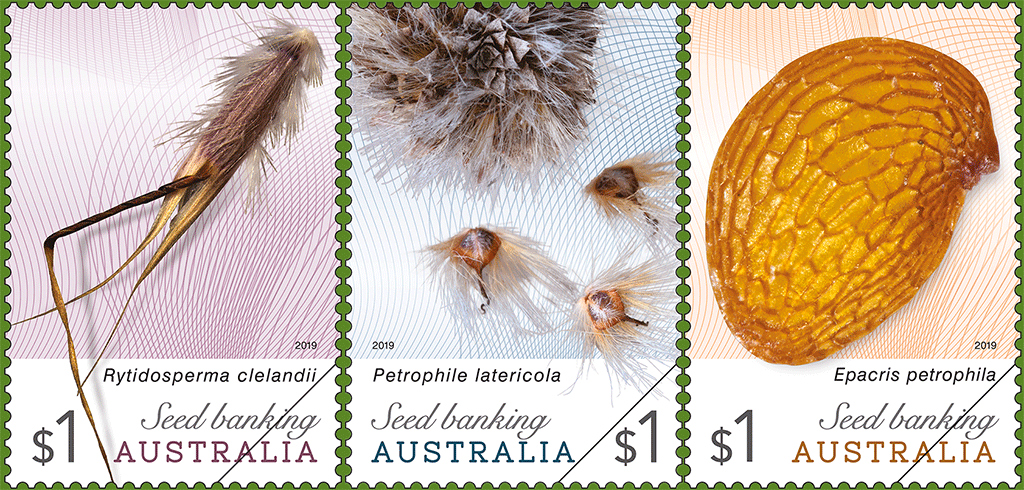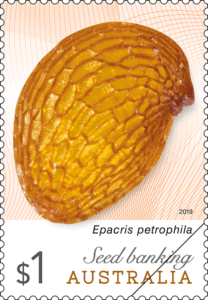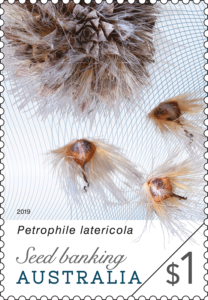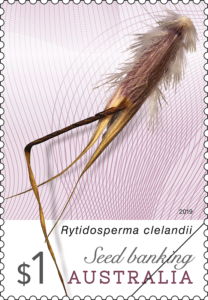[press release]
Stamping out extinction with seed banking
Australia Post is celebrating flora conservation through seed banking, with three striking domestic base-rate stamps featuring rare and at risk species.
Seed banking is well established globally as an essential insurance policy against extinction. It involves not only collection and storage of seed, but also provides a source of quality seed to aid species recovery, restoration of depleted plant communities and habitats, and for scientific research.
 Australia’s several major seed banks are associated with state, territory and council-run botanic gardens that collect and conserve wild native flora.
Australia’s several major seed banks are associated with state, territory and council-run botanic gardens that collect and conserve wild native flora.
Damian Wrigley, National Coordinator of the Australian Seed Bank Partnership, says: “Seed collection and storage are fundamental to the survival of many native flora species. We are thrilled that Australia Post is supporting flora conservation through this stamp issue.”
Speaking about the stamp release, Australia Post’s Philatelic Manager Michael Zsolt said it would help bring awareness to this issue.
“We’re so pleased we can represent the vital work of Australia’s seed banks in helping maintain species health and diversity across the country. Through macro-photography, the stamps offer a glimpse into the beauty of seeds – something not usually visible to the  naked eye,” he said.
naked eye,” he said.
The stamps depict some type, regional and habitat diversity, as well as the various means by which plants have evolved to spread their seeds. They show:
- Rytidosperma clelandii, also known as Cleland’s Wallaby-Grass, is a tufted perennial grass that is highly localised, growing only in the wetter parts of the Mount Lofty Ranges, in South Australia. Its short bristly hairs suggest it is transported in the fur and feathers of wildlife. This seed image was captured by Dan Duval, South Australian Seed Conservation Centre.
- Epacris petrophila, or Snow Heath, is a near-threated species that grows in the Australian Alps and in restricted high-altitude areas in Victoria and Tasmania. Its microscopic seeds suggest dispersal by wind or water, mixed with grain or soil, or in mud stuck to the feet of birds frequenting the same boggy habitat. This seed image was captured by Brook Clinton, National Seed Bank.
 Petrophile latericola is listed as endangered and occurs naturally only in areas south-east of Busselton on Western Australia’s southern Swan Coastal Plain. Its shuttlecock-like seeds suggest they are dispersed by the wind. This seed image was captured by Andrew Crawford, Western Australian Seed Centre, Kensington.
Petrophile latericola is listed as endangered and occurs naturally only in areas south-east of Busselton on Western Australia’s southern Swan Coastal Plain. Its shuttlecock-like seeds suggest they are dispersed by the wind. This seed image was captured by Andrew Crawford, Western Australian Seed Centre, Kensington.
The Seed Banking Australia stamp issue was designed by Sonia Young of the Australia Post Design Studio. It comprises three $1 stamps, a stamp pack, first day cover, maxicard set, three booklets of ten $1 stamps and a booklet collection.
The stamps and products are available at participating Post Offices, via mail order phone 1800 331 794, and online at auspost.com.au/stamps from 8 October 2019 while stocks last.



